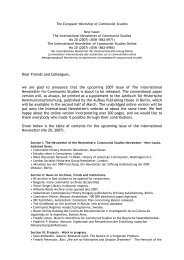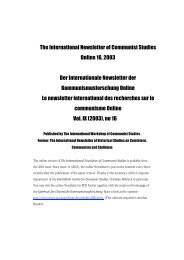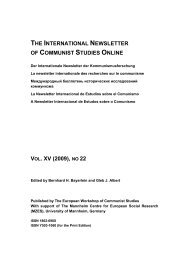Vol. XIII (2007), no 20 - The International Newsletter of Communist ...
Vol. XIII (2007), no 20 - The International Newsletter of Communist ...
Vol. XIII (2007), no 20 - The International Newsletter of Communist ...
Erfolgreiche ePaper selbst erstellen
Machen Sie aus Ihren PDF Publikationen ein blätterbares Flipbook mit unserer einzigartigen Google optimierten e-Paper Software.
<strong>The</strong> <strong>International</strong> Newletter <strong>of</strong> <strong>Communist</strong> Studies Online <strong>XIII</strong> (<strong><strong>20</strong>07</strong>), <strong>no</strong> <strong>20</strong> 34<br />
paid for in hard currency – Swedish, Danish, and Norwegian crowns, Dutch guilders, US<br />
dollars, German marks, French and Swiss francs, British pounds – which meant selling precious<br />
metals, principally gold.<br />
Considering the greater importance <strong>of</strong> gold movements for the fortunes <strong>of</strong> Communism than<br />
Nazism, why has the former phe<strong>no</strong>me<strong>no</strong>n attracted so much less scholarly <strong>no</strong>tice? One clue<br />
might lie in archival access. <strong>Communist</strong> sources relating to precious metals looting and Red<br />
army procurement (principally located at the Russian Government Archive <strong>of</strong> Eco<strong>no</strong>mics in<br />
Moscow, RGAE) have only been available to most researchers since 1991 – and this archive<br />
remains less well k<strong>no</strong>wn than the State and Party Archives – whereas captured Nazi files from<br />
the war have been combed over ever since 1945. Still, most <strong>of</strong> the Allied intelligence reports<br />
on the outflow <strong>of</strong> precious metals from Bolshevik Russia, the post-1917 equivalent <strong>of</strong><br />
Operation Safehaven, were declassified decades ago. <strong>The</strong> problem <strong>of</strong> Bolshevik gold may<br />
have disappeared from the history books, but it fairly screams out for attention in the foreign<br />
<strong>of</strong>fice files <strong>of</strong> the Entente powers – to anyone who looks at them. Contemporary newspaper<br />
accounts <strong>of</strong> the Russian Civil War and its aftermath, too, are full <strong>of</strong> colorful reporting about<br />
Russia’s rapidly dwindling precious metals reserves, artfully mixing hard fact, rumor, and the<br />
wildest speculation. <strong>The</strong> ongoing saga <strong>of</strong> Russian gold movements was, for years, a passing<br />
obsession <strong>of</strong> Entente diplomats and intelligence <strong>of</strong>ficers, many <strong>of</strong> whom left behind copious<br />
(though <strong>no</strong>t always accurate) documentation <strong>of</strong> their findings. 68<br />
Most striking <strong>of</strong> all, it turns out that many <strong>of</strong> the Bolsheviks’ principal foreign “financiers <strong>of</strong><br />
ge<strong>no</strong>cide”, unlike Switzerland’s stubborn “Nazi gold” apologists hiding behind banking secrecy<br />
laws, made <strong>no</strong> attempt to conceal their contributions to the triumph <strong>of</strong> Bolshevism. 69 If they<br />
were ever asked about their role in laundering stolen Bolshevik gold, silver, platinum, jewelry<br />
and diamonds, such men described these activities openly and with pride, even, in one<br />
extraordinary case, while under hostile police interrogation. 70 <strong>The</strong> same can be said <strong>of</strong> the<br />
Bolsheviks’ own commercial agents and buyers, the most important <strong>of</strong> which, like Leonid<br />
Krasin, wrote self-glorifying memoirs on the subject. 71 <strong>The</strong> story <strong>of</strong> Bolshevik gold<br />
68 <strong>The</strong> mother-source remains W. J. Novitsky, “Russian Gold Reserve,” unpublished ms, NAA 316, roll<br />
119. Novitsky’s analysis is also available at Columbia University’s Rare Book and Manuscript Library; a<br />
streamlined version was also published in the 4 July 19<strong>20</strong> New York Times as “Russian Gold Fund’s<br />
Adventures and Present Status.” An updated, and slightly more accurate, report is the 21 April 1921<br />
report <strong>of</strong> U.S. commercial attaché Charles Westcott, “Origin and Disposition <strong>of</strong> the Former Russian<br />
Imperial Gold Reserve,” also at NAA, 316, roll 1<strong>20</strong>.<br />
Both Novitsky and Westcott, along with those who relied on their reports, tended to underestimate<br />
Bolshevik precious metal reserves, in likelihood because neither was aware <strong>of</strong> the e<strong>no</strong>rmous scope <strong>of</strong><br />
illicit confiscations above and beyond the Bolshevik-captured portions <strong>of</strong> the Imperial Gold Reserve.<br />
Most allied observers, for example, remained unaware <strong>of</strong> the gold, platinum, silver, and diamonds<br />
hoarded at the Gokhran. In addition to the Gokhran files in RGAE fond 7632, opis 1, Gokhran-related<br />
material, such as the files <strong>of</strong> the “Safe Commission” (seifovaia kommissia), can also be found in RGAE<br />
fond 7733, opis 1.<br />
69 <strong>The</strong> phrase “financiers <strong>of</strong> ge<strong>no</strong>cide” is Lebor’s.<br />
70 <strong>The</strong> inimitable Ol<strong>of</strong> Aschberg, while being questioned at the Paris Préfecture de Police.<br />
71 Krasin, O vneshnei torgovle i ot<strong>no</strong>shenii k nei russkoi kooperatsii (Novgorod: Tipografiya Gubsoyuza,<br />
1921); Voprosyi vneshnei torgovli (Moscow: Gos. izdatel’stvo, 1928); Dela dav<strong>no</strong> minuvshikh dnei<br />
(Vospominaniia) (Moscow: Molodaia gvardiia, 1931).














